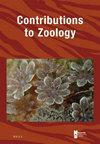不同长度鼻器官的新蝎蛉(昆虫纲:甲翅目:全景科)的婚食和生殖偶联
IF 2.2
2区 生物学
Q1 ZOOLOGY
引用次数: 7
摘要
新鸟属(Neopanorpa)是菊科第二大属,其主要特征是雄鸟三趾器官发育良好。然而,它仍然是很大程度上未知的鼻部器官的长度如何影响新鸟的交配摄食行为。本文通过比较a) Neopanorpa lui Chou & Ran(1981)与发育较弱的鼻部器官,b) N. carpentercheng(1957)与中等大小的鼻部器官,以及c) N. longiprocessaHua & Chou(1997)与极长鼻部器官的交配相关结构的形态和生殖偶联来研究交配喂养。N. lui和N. carpenteri夫妇保持间歇性的口对口模式,但不交换任何可食用的食物。之后雄性会分泌一团唾液到表面作为结婚礼物,而木氏乳蜂的唾液量明显大于吕氏乳蜂。与之相对应的是,雄唾液腺在木氏乳螨中比在吕氏乳螨中更为发达。长柄棘球线虫的雄性具有非常短的唾液腺,这与强制交配策略相对应。三种新鸟的生殖偶联现象相似。雄鱼的成对下瓣用来控制雌鱼的宫颈。雄柄柄突出的基突在节间膜上抓住雌柄柄的后部。雄性阴茎在生理上与雌性阴茎相结合,以确保雄性生殖器与雌性交配孔相连。本文简要地讨论了喙器官长度对新鹦鹉的交配摄食行为的影响。本文章由计算机程序翻译,如有差异,请以英文原文为准。
Nuptial feeding and genital coupling of Neopanorpa scorpionflies (Insecta: Mecoptera: Panorpidae) with notal organs of various lengths
Neopanorpa, the second largest genus in Panorpidae, is mainly characterized by the well-developed notal organ on male tergum III. However, it remains largely unknown how the length of the notal organ influences the nuptial feeding behaviour of Neopanorpa. Here, we investigated the nuptial feeding by comparing the morphology of mating-related structures and the genital coupling of a) Neopanorpa lui Chou & Ran, 1981 with a weakly-developed notal organ, b) N. carpenteri
Cheng, 1957 with a medium-sized notal organ, and c) N. longiprocessa
Hua & Chou, 1997 with an extremely elongated notal organ. The couples of N. lui and N. carpenteri maintain an intermittent mouth-to-mouth mode but do not exchange any edible food. After that the males secrete a salivary mass onto the surface as a nuptial gift, which is distinctly larger in N. carpenteri than in N. lui. Correspondingly, the male salivary glands are more developed in N. carpenteri than in N. lui. Males of N. longiprocessa bear very short salivary glands corresponding to a coercive mating tactic. The genital couplings are similar among the three species of Neopanorpa. The paired hypovalves of males are used to control the cerci of females. The prominent basal processes of male gonostyli grasp the posterior portion of the female medigynium across the intersegmental membrane. The male aedeagus physically couples with the female medigynium to ensure the male phallotreme to connect to the female copulatory pore. The influence of the notal organ length on the nuptial feeding behaviour of Neopanorpa is briefly discussed.
求助全文
通过发布文献求助,成功后即可免费获取论文全文。
去求助
来源期刊

Contributions to Zoology
生物-动物学
CiteScore
4.00
自引率
4.50%
发文量
16
审稿时长
>12 weeks
期刊介绍:
Contributions to Zoology solicits high-quality papers in all systematics-related branches of comparative zoology (including paleozoology). Preference will be given to manuscripts dealing with conceptual issues and to integrative papers (e.g., ecology and biodiversity, morphology and phylogeny and character state evolution, phylogeny and historical biogeography, systematics and bioinformatics, bioinformatics and biodiversity, habitat disturbance and biogeography, etc.). Reviews and alpha-taxonomic contributions are considered for publication, but acceptance will depend on their high quality and exceptional nature.
 求助内容:
求助内容: 应助结果提醒方式:
应助结果提醒方式:


